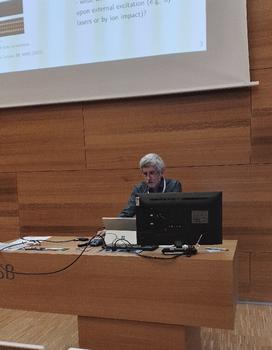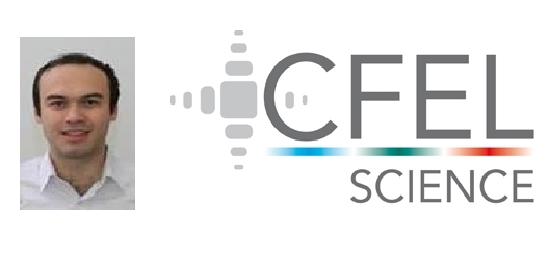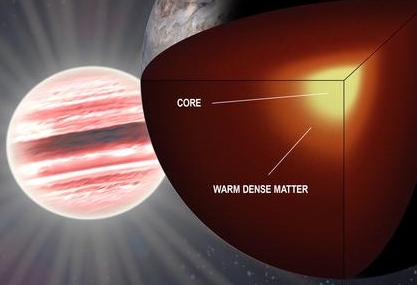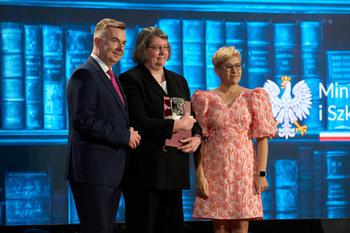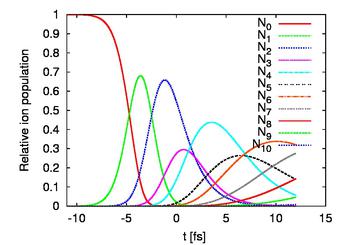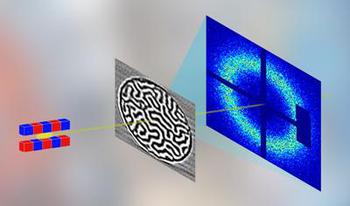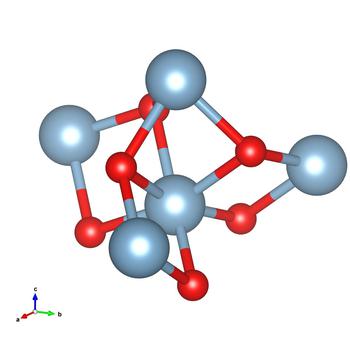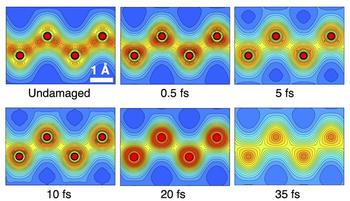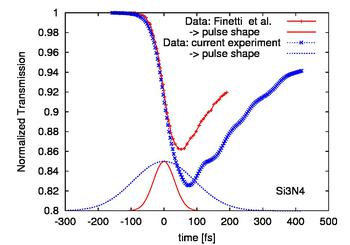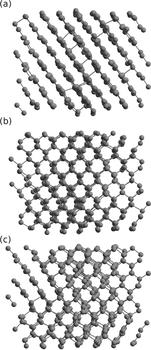Research Highlights
10. Joint SATELLITE WORKSHOP of European XFEL & CFEL, DESY: "Liquids and solids in intense X-ray light - Theory Workshop"
The meeting took place on Thursday 23.01.25, from 9:30 to 16:00 at the CSSB Lecture Hall at DESY. It included 6 invited talks by international and local lecturers on the respective theory advances in modelling interaction of liquids and solids with intense X-ray pulses with implications for diffractive imaging, solid state physics, warm-dense-matter and plasma research. Participation was open to all interested users of photon science facilities, attending the European XFEL and DESY Photon Science Users' Meetings. In total, 177 participants registered for the satellite workshop, 50-60 participants were present during the meeting.
Photo: Prof. Michael Bonitz from Kiel University (CAU) during his lecture on "Nonequilibrium Green functions simulations of femtosecond dynamics of quantum materials".
9. Victor Tkachenko wins the best presentation prize at the CFEL Symposium held in Timmendorfer Strand in October 2024.
On the photo: Dr. Victor Tkachenko
8. European X-ray laser explores an exotic state of matter
"The properties of warm dense matter have until recently been little known. Now, thanks to the use of X-ray lasers, physicists are gaining more and more information about this important but still mysterious state of matter. The first comprehensive observations of ionisation processes in warm dense matter, carried out at the European X-ray Free-Electron Laser (European XFEL), supported by the state-of-the-art theory simulations have just been presented in one of the most prestigious physics journals."
See [Mercadier, L., Benediktovitch, A., Krušič, Š. et al. (BZ), Transient absorption of warm dense matter created by an X-ray free-electron laser, Nat. Phys. 20, 1564–1569 (2024). https://doi.org/10.1038/s41567-024-02587-w ]
https://press.ifj.edu.pl/en/news/2024/08/07/
https://www.eurekalert.org/news-releases/1054008
Figure: Warm dense matter occurs inside Jupiter-type giant planets (where it surrounds the rocky core as a metallic liquid at a temperature of many thousands of Kelvin) and in the interiors of small stars – brown dwarfs (Source NASA / IFJ PAN).
7. Beata Ziaja-Motyka honoured for her outstanding scientific achievements:
"Beata Ziaja-Motyka, group leader at the Center for Free-Electron Laser Science (CFEL) at the Deutsches Elektronen-Synchrotron DESY in Hamburg and full professor at the Henryk Niewodniczański Institute of Nuclear Physics of the Polish Academy of Sciences (IFJ PAN) in Krakow, received the prestigious Award of the Polish Ministry of Science and Higher Education. The award ceremony took place at the annual Polish Science Gala on 18 February 2024, where Prof. Dr. Ziaja-Motyka was honoured for her groundbreaking scientific achievements in recent years. The award recognizes her pioneering work in the field of femtosecond physics and the study of materials under intense irradiation with pulses from X-ray free-electron laser, e.g., the European XFEL."
https://www.xfel.eu/news_and_events/news/index_eng.html?openDirectAnchor=2300&two_columns=0
https://www.gov.pl/web/nauka/gala-nauki-polskiej4
On the photo:
Polish Ministry of Science and Higher Education honored Beata Ziaja-Motyka for her outstanding achievements in the field of femtosecond physics (from left to right: Polish Minister of Science and Higher Education, Dariusz Wieczorek, Prof. Dr. Beata Ziaja-Motyka, Deputy Minister of Science and Higher Education, Maria Mrówczyńska) Copyright: Beniamin Motyka
6. X-ray lasers: Why does brighter mean darker?
"When we illuminate something, we usually expect that the brighter the source we use, the brighter the resulting image will be. This rule also works for ultra-short pulses of laser light – but only up to a certain intensity. The answer to the question why an X-ray diffraction image 'darkens' at very high X-ray intensities does not only deepen fundamental understanding of the light-matter interaction, but also offers a unique perspective for the production of laser pulses that have significantly shorter pulse duration than those currently available."
See [I. Inoue, J. Yamada, K. J. Kapcia, M. Stransky, V. Tkachenko, Z. Jurek, T. Inoue, T. Osaka, Y. Inubushi, A. Ito, Y. Tanaka, S. Matsuyama, K. Yamauchi, M. Yabashi, B. Ziaja; "Femtosecond reduction of atomic scattering factors triggered by intense x-ray pulse”,Physical Review Letters, 131, 16, 2023; DOI: https://doi.org/10.1103/PhysRevLett.131.163201 ]
https://www.eurekalert.org/news-releases/1005250
https://press.ifj.edu.pl/en/news/2023/10/18/
https://forumakademickie.pl/badania/lasery-rentgenowskie-dlaczego-jasniej-oznacza-ciemniej/
5. An X-ray step towards superfast nanoelectronics:
"When a material with magnetic properties is illuminated by a pulse from an X-ray laser, it instantly demagnetises. This phenomenon, so far poorly understood, could in the future be used in nanoelectronics, to build, for example, ultrafast magnetic switches. An important step toward this goal is a new simulation tool developed by a Polish-German-Italian team of scientists as a part of a joint research project between the European XFEL and IFJ PAN."
See [Kapcia, K.; Tkachenko, V.; Capotondi, F.; Lichtenstein, A.; Molodtsov, S.; Müller, L.; Philippi-Kobs, A.; Piekarz, P.; Ziaja, B., "Modeling of ultrafast X-ray induced magnetization dynamics in magnetic multilayer systems", npj computational materials 8(1), 212 (2022) [10.1038/s41524-022-00895-4] ].
https://www.eurekalert.org/news-releases/974571
https://press.ifj.edu.pl/en/news/2022/12/14/
https://www.xfel.eu/news_and_events/news/index_eng.html?openDirectAnchor=2042&two_columns=0
DESY Photon Science News 2022 (website)
4. Salutary delay in the reaction of crystal atoms to an intense photon pulse:
"Using X-ray FEL pulses, the structure of matter can be studied with previously unprecedented accuracy, although the pulses are so intense that they ultimately destroy the irradiated sample. Notwithstanding, an international team of physicists has succeeded in demonstrating that atoms of the Al2O3 crystal under investigation react to an X-ray pulse with a certain delay. The observation implies that by using sufficiently short intense laser pulses, it will be possible achieve high-resolution structure determination with the accuracy of the order of 0.01 Å in coherent diffraction studies of nanocrystals."
See [Inoue, I.; Tkachenko, V. ; Kapcia, K. J. ; Lipp, V.; Ziaja, B. ; Inubushi, Y. ; Hara, T. ; Yabashi, M.; Nishibori, E., "Delayed Onset and Directionality of X-Ray-Induced Atomic Displacements Observed on Subatomic Length Scales", Physical Review Letters 128(22), 223203 (2022) [10.1103/PhysRevLett.128.223203] ]
https://www.eurekalert.org/news-releases/958798
https://press.ifj.edu.pl/en/news/2022/07/14/
DESY Photon Science News 2022 (website)
3. Ultrafast melting of diamond:
"An international team of scientists has found evidence of an unconventional 'non-thermal' melting process in diamond induced by an intense X-ray free-electron laser beam. While in conventional melting the heated atoms of a sample start moving stronger and stronger until the interatomic bonds break, the intense X-ray laser flashes can excite so many electrons that this reorganizes the interatomic potential on femtosecond timescale and breaks the bonds between carbon atoms apart straight away. The scientists around Ichiro Inoue from the RIKEN SPring-8 Center in Japan, Eiji Nishibori from University of Tsukuba in Japan and DESY & INP PAS scientist Beata Ziaja have recently reported their observations on X-ray induced ultrafast melting of diamond in the journal Physical Review Letters (2021): https://journals.aps.org/prl/abstract/10.1103/PhysRevLett.126.117403."
See DESY News [https://www.desy.de/news/news_search/index_eng.html?openDirectAnchor=2040&two_columns=0], DESY Highlights 2021, DESY FEMTO 02/21, page 31,[https://www.desy.de/femto_eng/]
2. Towards better temporal diagnostics of ultrafast X-ray pulses:
''Spatially encoded measurements of transient optical transmissivity became a standard tool for temporal diagnostics of free-electron-laser (FEL) pulses. The modern experimental techniques can measure changes in such optical coefficients with a temporal resolution better than 10 fs. This, in an ideal case, would imply a similar resolution for the temporal pulse properties and the arrival time jitter between the FEL and optical laser pulses. The observed changes of transient optical coefficients are due to the emergent carriers, electron and holes, produced in the X-ray excited material. However, additional processes such as carrier transport and carrier recombination can make the diagnostic measurement inaccurate. In a combined experimental and theoretical study, an international team, with participating IFJ PAN scientists, identified the main processes contributing to the unwanted escape of carriers during diagnostic measurement. By controlling their contribution in future applications, one can gain a very high temporal resolution for the reconstruction of FEL pulse properties measured with semiconductor based diagnostic tools. The results have been published in the journal Scientific Reports (2021): https://www.nature.com/articles/s41598-021-84677-w#Bib1 ''
See INP PAS News [https://press.ifj.edu.pl/en/news/2021/03/04-2/]
1. Versatile tool XTANT+ to study response of various materials to X-ray pulses:
''Intense X-ray pulses from free-electron lasers can trigger ultrafast electronic, structural and magnetic transitions in solid materials, within a material volume which can be precisely shaped through adjustment of X-ray beam parameters. This opens unique prospects for material processing with X-rays. However, any fundamental and applicational studies are in need of computational tools, able to predict material response to X-ray radiation. Here we present a dedicated computational approach XTANT+ developed to study X-ray induced transitions in a broad range of solid materials, including those of high chemical complexity. The latter becomes possible due to the implementation of the versatile density functional tight binding code DFTB+ to follow band structure evolution in irradiated materials. The outstanding performance of the implementation is demonstrated with a comparative study of XUV induced graphitization in diamond. The results have been published in the journal Scientific Reports (2022): https:// doi.org/10.1038/s41598-022-04775-1."
